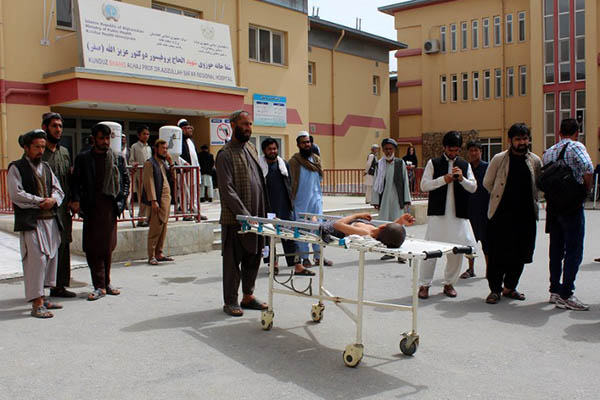
Bashir Khan Safi—AFP
Defense ministry suggests Taliban opened fire on civilians
The United Nations said on Tuesday it was investigating “disturbing reports of serious harm to civilians” in an Afghan airstrike on a religious school that security sources say left dozens of children dead or wounded.
Hundreds of people were attending a graduation ceremony at the madrassa in a Taliban-controlled northeastern district on Monday when Afghan Air Force helicopters struck, witnesses have told AFP. “Human Rights team on ground establishing facts. All parties reminded of obligations to protect civilians from impact of armed conflict,” the United Nations Assistance Mission in Afghanistan said in a brief statement.
At least 59 people, including Taliban commanders meeting at the compound in the Dashte Archi district in Kunduz province, were killed in the attack, Afghan security sources told AFP on condition of anonymity. Most of the civilian victims were children, they said. Government officials in both Kabul and Kunduz have given conflicting figures, with some denying any civilians had been killed or that a madrassa had been hit. Afghan officials have been known to minimize civilian casualties.
“I myself counted 35 bodies,” Abdul Khalil told AFP at the hospital in the provincial capital Kunduz—more than 50 kilometers from the airstrike—where health officials said 57 injured had been taken. “I arrived at the scene right after the airstrikes—it was like a butcher’s shop. Everywhere was covered with blood, the ground was littered with body parts, heads, limbs and other parts.”
A man called Yousuf, who was at the ceremony when the airstrikes happened, told AFP he saw “blood and body parts everywhere.” Television showed anguished relatives standing outside the hospital yelling “Shame on you!”
Defense ministry spokesman Mohammad Radmanish on Tuesday distanced the air force from responsibility for civilian casualties—which on Monday he had denied existed—and instead suggested the Taliban opened fire on them. “Half of them [civilians in hospital] have gunshot wounds, hit by light weapons that we didn’t use. We used rockets fired by MD-530 helicopters—how were they hit by bullets?” he said.
But Naim Mangal, a doctor at the hospital, said “all the victims” had been “hit by pieces of bomb, shrapnel.”
“Out of the 100 wounded and six dead in the hospital none have been hit by a bullet,” he told AFP.
Radmanish said 18 senior Taliban commanders were killed in the airstrike on a “training center” for the group’s elite Red Unit. Another 12 were wounded. Earlier he had said 20 Taliban were killed. The government has sent two teams to conduct an investigation into the incident, he added.
Kunduz police chief General Abdul Hamid Hamidi told AFP on Tuesday that “72 of the enemy” had been killed in the airstrike. Hamidi added that five civilians also died and another 52 were wounded but he denied a madrassa or mosque had been hit. Security forces have donated large quantities of blood to the hospital.
The Taliban has confirmed the attack on the religious school but denied that any of its militants had been there.
The madrassa was run by Islamic scholars sympathetic to the Taliban but the facility was open to the public, a senior Taliban commander speaking from an unknown location in Pakistan told AFP on Tuesday. He said as many as 2,000 people were at the school on Monday, including 750 students, for a graduation ceremony, but insisted there were no senior Taliban leaders present. He estimated that 400 people had been killed and an unknown number wounded. The Taliban are known to exaggerate battlefield claims.
Several boys with their arms and legs bandaged were seen lying in beds and along the corridors of the hospital. One of the security sources said the Taliban had started meeting at madrassas in the hope of avoiding airstrikes.
U.S. and Afghan forces are increasing ground and air offensives against Taliban and Islamic State insurgents as they try to get the upper hand in the 16-year war.
